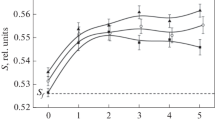Abstract
Using the methods of positron annihilation and optical spectroscopy, the effect of gamma (Co60) and electron irradiation (Cockcroft–Walton accelerator) on NaCl single crystals, followed by annealing at various temperatures. It was found that electron color centers are effective traps of positrons diffusing in the lattice. At the same time, hole centers do not capture positrons. It was shown that positrons are captured by sodium clusters formed in the bulk of NaCl crystals upon annealing (443 K) of irradiated (2650 Mrad) samples. The annihilation characteristics of captured positrons allow us to estimate size of sodium clusters R = 23.0 nm and their concentration Nx = 5.3 × 1017 cm–3. Taking into account the fact that modern optical and positron spectrometers are quite compact and sensitive instruments, the monitoring of the processes of radiation degradation of the geological rock of rock salt can be carried out directly at the disposal sites of radioactive waste rather quickly and with the necessary degree of sensitivity to the accumulation of radiolytic products.


Similar content being viewed by others
Notes
In further studies, it was shown that upon irradiation of NaCl samples, H and F centers are formed, which aggregate with the formation of chlorine bubbles and nanoscale sodium clusters. Rapidly growing voids bring chlorine bubbles and Na colloids into contact, which can lead to an instantaneous reverse explosive reaction between radiolytic Na and Cl [3–5].
REFERENCES
Kerr, R.A., Science, 1999, vol. 283, p. 1626.
Gies, H., Hild, W., Kuhle, T., and Monig, J., Radiation Effects in Rock Salts, GSF-Report 9/93, München: GSF, 1994.
Den Hartog, H.W., Radiat. Eff. Defects Solids, 1999, vol. 150, nos. 1–4, pp. 167–172. https://doi.org/10.1080/10420159908226225
Lidiard, A.B., Philos. Mag., 1979, vol. 39, p. 647.
Dubinko, V.I., Turkin, A.A., Vainshtein, D.I., and Hartog, H.W., J. Nucl. Mater., 2001, vol. 289, p. 86.
Forsyth, R.S. and Werme, L.O., J. Nucl. Mater., 1992, vol. 190, p. 3.
Positron Solid State Physics, Brandt, W. and Dupasquier, A., Eds., Amsterdam: North Holland, 1983.
Grafutin, V.I. and Prokop’ev, E.P., Usp. Fiz. Nauk, 2002, vol. 172, no. 1, pp. 67–83.
Brandt, W., Appl. Phys., 1974, vol. 5, pp. 1–23.
Bardyshev, I.I. and Fomkin, A.A., Prot. Met., 2008, vol. 44, no. 4, p. 358.
Tsivadze, A.Yu., Fridman, A.Ya., Averin, A.A., et al., Prot. Met. Phys. Chem. Surf., 2019, vol. 55, no. 6, pp. 1071–1079.
Bardyshev, I.I., Gol’danskii, A.V., Kotenev, V.A., and Tsivadze, A.Yu., Prot. Met. Phys. Chem. Surf., 2018, vol. 54, no. 4, pp. 648–651.
Bardyshev, I.I., Buravov, A.D., Gol’danskii, A.V., Vysotskii, V.V., Kotenev, V.A., and Tsivadze, A.Yu., Prot. Met. Phys. Chem. Surf., 2019, vol. 55, no. 5, pp. 1015–1018.
Chuang, S.Y., Jan, G.J., and Tseng, P.K., J. Appl. Phys., 1981, vol. 52, p. 233. https://doi.org/10.1063/1.328483
Nicholas, J.B., Tumosa, C.S., and Ache, H.J., J. Chim. Phys., 1973, vol. 58, p. 2902. https://doi.org/10.1063/1.1679596
Brandt, W. and Paulin, R., Phys. Rev. B, 1973, vol. 8, no. 9, pp. 4125–4133.
West, R.N., Adv. Phys., 1973, vol. 22, no. 3, pp. 263–383.
Inabe, K., Takeucbi, N., and Owaki, S., Nucl. Instrum. Methods Phys. Res., Sect. B, 1991, vol. 91, pp. 201–204; Bardyshev, I.I., Skvortsov, A.G., Barsova, L.I., and Spitsyn, V.I., Tezisy dokladov 5-ogo Vsesoyuznogo soveshchaniya po radiatsionnoi fizike i khimii ionnykh kristallov (Proc. 5th All-Union Conference on Radiation Physics and Chemistry of Ion Crystals), Riga, October 4–6, 1983, part 1, p. 284.
Lang, G., DeBenedetti, S., and Smoluchowski, R., Phys. Rev., 1955, vol. 99, pp. 596–598.
Tumosa, C.S., Nicholas, J.B., and Ache, H.J., J. Phys. Chem., 1971, vol. 75, p. 2030.
Brandt, W. and Waung, H.F., Phys. Rev., 1971, vol. 133, p. 3432.
Compton, W.D., Phys. Rev., 1957, vol. 107, p. 1271.
Kittel, Ch., Introduction to Solid State Physics, New York: Wiley, 1953.
Author information
Authors and Affiliations
Corresponding author
Rights and permissions
About this article
Cite this article
Bardyshev, I.I., Kotenev, V.A. Control of Radiation Defects and Na Clusters in the Process of Radiation Degradation of Natural Stone Salt Single Crystals. Prot Met Phys Chem Surf 56, 844–848 (2020). https://doi.org/10.1134/S2070205120040073
Received:
Revised:
Accepted:
Published:
Issue Date:
DOI: https://doi.org/10.1134/S2070205120040073



